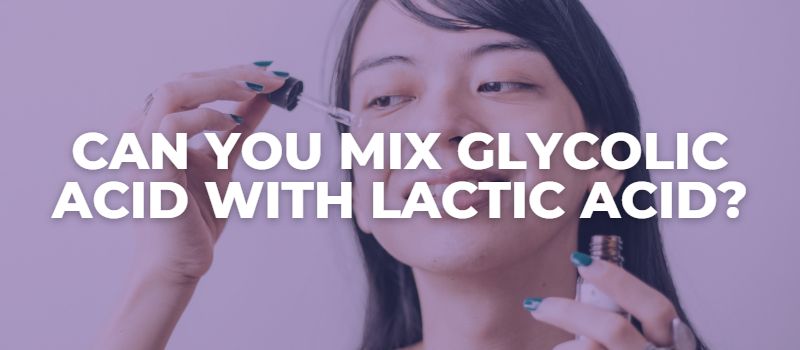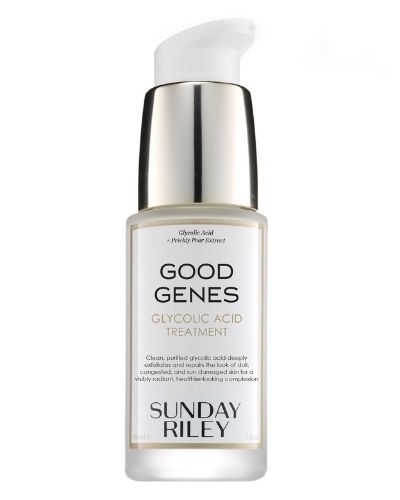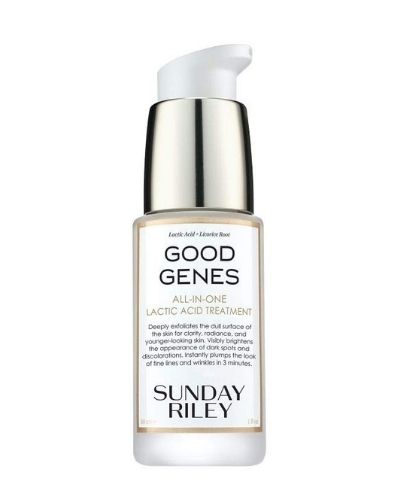When used together, glycolic acid and lactic acid can help improve skin tone and texture and reduce the appearance of pigmentary irregularities and signs of aging.
However, it’s best to use these two exfoliating acids when they are formulated in one product.
Doubling up on acids can exacerbate skin concerns, so it’s important to be cautious when mixing the two.
In this article, we will discuss the benefits of having both ingredients in your skincare regimen, as well as how to use glycolic and lactic acid together for the best effect without the risk of irritating your skin.

How Does Glycolic Acid Work?

Glycolic acid is a naturally occurring component in sugar cane, sugar beets, pineapple, papaya, tomatoes, cantaloupe, and unripe grapes.
However, the glycolic acid used in skincare products is synthetically made in a lab due to being more stable and safer overall.
Glycolic acid is the strongest and most potent member of the family of AHAs, and this is due to having the smallest molecular weight, which allows it to penetrate the skin easier and work faster.
Glycolic acid is also a water-soluble substance, which means it can work on the surface layer of the skin; however, it cannot cut through the oil and penetrate deeper into the pores, so it is most useful for superficial exfoliation.
Superficial exfoliation can be beneficial for targeting various skin concerns, including lines and wrinkles, hyperpigmentation, uneven skin tone, and texture.
But although salicylic acid is the chief anti-acne ingredient when it comes to exfoliating acids, glycolic acid can also be good for acne-prone skin.
This is because glycolic acid also has antibacterial properties, and regular exfoliation prevents excess dead skin cells from clogging up the pores and contributing to acne.
Some benefits of using glycolic acid are:
- Brighter complexion.
- Smoother skin texture.
- Improved scarring.
- Improved hyperpigmentation.
- Improved appearance of fine lines and wrinkles.
- Evened out skin tone.
- Decreased acne.
- Hydrated and healthy skin.
How Does Lactic Acid Work?

Lactic acid is an exfoliating acid derived from sour milk or sugar-rich foods, and it’s a water-soluble substance with larger molecules, making it slightly different from glycolic acid.
Due to its large molecules, lactic acid won’t penetrate deeper into the skin and will instead work on the surface, which means it will provide lighter exfoliation, making it more suitable for sensitive skin.
Lactic acid is also a humectant, which means it attracts water molecules and helps retain them in the skin.
When applied topically, it pulls moisture from the air and helps the skin retain it, thus hydrating and plumping the skin.
Additionally, lactic acid also promotes ceramide production, which helps strengthen the skin barrier and normalize its function.
Some benefits of using lactic acid include:
- Smoother and more uniform complexion.
- Improved hyperpigmentation.
- Dissolved closed comedones.
- Evened out skin tone.
- Refined texture.
RELATED: Best Serums for Textured Skin.
Can You Use Lactic Acid and Glycolic Acid Together?
Lactic acid and glycolic acid can be used together, particularly when they are in the same skincare product.
This is because a product containing a combination of acids is usually formulated with milder potencies of the active ingredients to target various skin concerns without causing dryness, sensitivities, and discomfort.
However, it’s important to be cautious when using both acids together when using separate products, as doubling up on exfoliation can irritate the skin and compromise its barrier.
Products containing a single acid are usually stronger, so layering them on top of each other can be overwhelming for your skin.
To avoid over-exfoliating, it’s best to stick to one product at a time, depending on your main skin concerns, or try a blend of lactic and glycolic acids for a more balanced treatment.
This can also help you save time and money on purchasing multiple products and can also give you better results with minimal risk of side effects.
The Benefits of Combining Glycolic Acid with Lactic Acid
Here are a few benefits of mixing glycolic acid and lactic acid:
- Wrinkle Reduction: Both glycolic and lactic acid improve the appearance of fine lines and wrinkles, especially in areas with thinner skin, like the forehead.
- Hydration and Moisturization: Glycolic and lactic acid have hydrating and moisturizing properties that plump and revive the skin’s youthful complexion.
- Brighter Skin Tone: With consistent use, these acids lead to a brighter and more even skin tone.
- Smoother Texture: Regular application of glycolic and lactic acid results in smoother skin texture and decreased hyperpigmentation and sun damage.
- Improved Complexion: Over time, expect improved lines and wrinkles, resulting in healthier, plumper, and more uniform skin.
The Side Effects of Combining Glycolic Acid with Lactic Acid
Using glycolic and lactic acid together can have several potential risks and side effects, including:
- Skin Irritation: Combining glycolic and lactic acid can lead to skin irritation due to removing dead skin cells which are essential in strengthening the skin barrier.
- Redness: Overusing or misusing these acids can cause redness, especially in people with sensitive skin.
- Burning: Some people may experience a burning sensation due to the acidic nature of these ingredients or a compromised skin barrier.
- Dryness: These acids can lead to dryness as they strip away the top layer of the skin and cause moisture loss.
- Hyperpigmentation: High-strength AHAs can sometimes cause post-inflammatory hyperpigmentation or dark spots, particularly in darker skin tones.
- Sun Sensitivity: Exfoliating acids can make your skin more sensitive to the sun and susceptible to sunburns, so wearing sunscreen daily when using these products is essential.
How to Safely Use Glycolic Acid and Lactic Acid Together?
To safely incorporate lactic acid and glycolic acid in your skincare routine, consider a combined product rather than two separate ones.
Using two different products can be unnecessarily costly and may not yield significant additional benefits.
This is because most skincare formulas containing these acids are potent, so it’s advisable to limit use to 2-3 times a week to avoid over-exfoliation, which may cause the products to expire before you’ve used them up, leading to wastage and an ineffective cost strategy.
Therefore, an optimal solution is to find a product containing both glycolic and lactic acid, which allows you to benefit from both acids’ properties without needing multiple products.
However, if your skin has specific needs, you may want to choose a product containing just one of these acids.
For example, glycolic acid is more suitable for addressing acne, wrinkles, and hyperpigmentation, and it can also help even out skin tone issues caused by conditions like melasma.
Lactic acid, on the other hand, is ideal for sensitive skin types looking to target dryness, dehydration, and uneven texture.
Therefore, always consider your skin’s needs and sensitivities before incorporating potent acids into your skincare routine, as you may need to adjust the frequency and potency of use for a safer and more effective experience.
Best Serums with Glycolic Acid and Lactic Acid
The best way to combine glycolic and lactic acid in your skincare routine is to use a serum that contains both ingredients.
Here are a few excellent serums with glycolic and lactic acid:
REN Glycol Lactic Radiance Renewal Mask
Best for all skin types.
The REN Glycol Lactic Radiance Renewal Mask is a bio-active peel mask designed to renew the complexion, improve skin tone and texture, and reduce the appearance of fine lines and wrinkles.
Its unique gel-like consistency allows for easy and smooth application, while the fusion of glycolic and lactic acids work synergistically to exfoliate the top layer of skin, revealing a brighter, healthier complexion beneath.
The formula also includes papaya enzymes, known for their skin-smoothing properties, and natural fruit acids from passion fruit, lemon, grape, and pineapple to further refine skin texture.
This mask is perfect for those seeking a quick, at-home treatment that delivers professional-grade results.
Paula’s Choice Advanced Smoothing Treatment 10% AHA Serum
Best for all skin types.
The Paula’s Choice Advanced Smoothing Treatment 10% AHA Serum is a multi-tasking exfoliant that promises smoother, brighter, and more even-toned skin.
Its lightweight, milky texture allows for easy application and quick absorption while the blend of potent AHAs such as glycolic, lactic, malic, and tartaric acids, coupled with skin-soothing antioxidants, exfoliate and renew the skin and calm inflammation.
Regular use of this serum can lead to improved skin texture, reduced appearance of wrinkles, and a more radiant complexion.
Murad Replenishing Multi-Acid Peel
Best for dry, mature, and lackluster skin.
The Murad Replenishing Multi-Acid Peel is a daily bi-phase peel that rejuvenates and nourishes the skin for a vibrant glow.
Its dual-phase formula features a blend of AHA’s, including glycolic and lactic acids, and a nourishing oil phase containing Holy Basil and omega-rich oils, which accelerate cell renewal and smooth the skin.
The lightweight, fast-absorbing texture ensures easy application and leaves the skin feeling soft and refreshed.
With regular use, this peel promotes a more uniform skin tone, reduces the appearance of fine lines, and enhances overall skin radiance.
SkinCeuticals Renew Overnight Dry
Best for dry, dehydrated, and dull skin.
The SkinCeuticals Renew Overnight Dry is a potent and rejuvenating night cream tailored for normal or dry skin.
Its creamy, fast-absorbing formula boasts a blend of alpha-hydroxy acids, including glycolic and lactic acids, which work overnight to exfoliate and hydrate the skin gently.
It also includes botanical extracts and a delivery system optimized for dry skin.
With regular use, this cream can enhance skin radiance, smoothness, and texture while reducing the appearance of fine lines and wrinkles.
Vivant Skin Care Exfol-A
Best for oily, coarse, and acne-prone skin.
The Vivant Skin Care Exfol-A is a potent vitamin A-based serum with a light, non-greasy consistency that absorbs quickly into the skin. It incorporates a blend of alpha-hydroxy acids, including glycolic and lactic acids, that work together to exfoliate, while vitamin A accelerates cell turnover and promotes skin renewal.
This action results in clearer, firmer, smoother skin with a reduced appearance of acne, hyperpigmentation, fine lines, and a more refined skin texture.
Regular use of this serum can lead to radiant, rejuvenated skin with a youthful glow, reduced redness, faded hyperpigmentation, and an overall refined complexion.

My name is Simone and I am a certified skin specialist. I created this website to teach my readers how to take great care of their skin and I also like to occasionally share my honest opinions on skincare products I’ve tried. You can learn more about me here.
